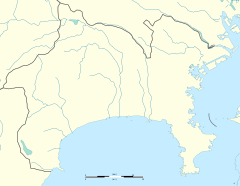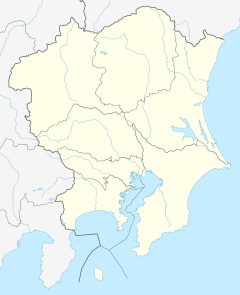Fujisawa Station
 South entrance of Fujisawa Station, 2021 | ||||||||||||||||||||||||||||||||||||||||||||||||||||||||||
| Japanese name | ||||||||||||||||||||||||||||||||||||||||||||||||||||||||||
| Shinjitai | 藤沢駅 | |||||||||||||||||||||||||||||||||||||||||||||||||||||||||
| Kyūjitai | 藤澤驛 | |||||||||||||||||||||||||||||||||||||||||||||||||||||||||
| Hiragana | ふじさわえき | |||||||||||||||||||||||||||||||||||||||||||||||||||||||||
| General information | ||||||||||||||||||||||||||||||||||||||||||||||||||||||||||
| Location | 1 Minamifujisawa, Fujisawa City, Kanagawa Prefecture 251-0055 Japan | |||||||||||||||||||||||||||||||||||||||||||||||||||||||||
| Coordinates | 35°20′14″N 139°29′14″E / 35.33722°N 139.48722°E | |||||||||||||||||||||||||||||||||||||||||||||||||||||||||
| Operated by | ||||||||||||||||||||||||||||||||||||||||||||||||||||||||||
| Line(s) | ||||||||||||||||||||||||||||||||||||||||||||||||||||||||||
| Distance | 51.1 km (31.8 mi) from Tokyo | |||||||||||||||||||||||||||||||||||||||||||||||||||||||||
| Connections | ||||||||||||||||||||||||||||||||||||||||||||||||||||||||||
| Other information | ||||||||||||||||||||||||||||||||||||||||||||||||||||||||||
| Status | Staffed (Midori no Madoguchi ) | |||||||||||||||||||||||||||||||||||||||||||||||||||||||||
| History | ||||||||||||||||||||||||||||||||||||||||||||||||||||||||||
| Opened | 11 July 1887 | |||||||||||||||||||||||||||||||||||||||||||||||||||||||||
| Passengers | ||||||||||||||||||||||||||||||||||||||||||||||||||||||||||
| FY2019 | 108,873 (JR East, boarding) 165,663 (Odakyu, daily) 22,968 (Enoden, daily) | |||||||||||||||||||||||||||||||||||||||||||||||||||||||||
| Services | ||||||||||||||||||||||||||||||||||||||||||||||||||||||||||
| ||||||||||||||||||||||||||||||||||||||||||||||||||||||||||
| ||||||||||||||||||||||||||||||||||||||||||||||||||||||||||
Fujisawa Station (藤沢駅, Fujisawa-eki) is an interchange passenger railway station located in the city of Fujisawa, Kanagawa, Japan, operated by East Japan Railway Company (JR East) and the private railway operators Odakyu Electric Railway and Enoshima Electric Railway. Clustered around the station are large department stores and office buildings, forming the center of the city.
Lines
This station is served by the JR East Tōkaidō Main Line with, with some through services via the Shōnan-Shinjuku Line, the Odakyu Enoshima Line, and the Enoshima Electric Railway. The station lies 51.1 km (31.8 mi) from the official starting point of the Tōkaidō Main Line at Tokyo Station.
Station layout
JR East
JR East uses two island platforms connected by a footbridge to the main station building. Platforms 1 and 2 are used by Shōnan services. The station has a Midori no Madoguchi staffed ticket office.
| 1 | ■ Tōkaidō Line (Shōnan) | for Shinagawa and Tokyo for Shinjuku |
| 2 | ■ Tōkaidō Line (Shōnan) | for Chigasaki, Hiratsuka and Odawara |
| 3 | JT Tōkaidō Line (Ueno-Tokyo Line) |
for Yokohama, Tokyo, Ueno, Ōmiya JU Utsunomiya Line for Utsunomiya and Kuroiso JU Takasaki Line for Takasaki and Maebashi |
| JS Shōnan-Shinjuku Line | for Yokohama, Shibuya, Shinjuku, Ikebukuro, Ōmiya, Takasaki and Maebashi (via JU Takasaki Line) | |
| 4 | JT Tōkaidō Line | for Hiratsuka, Kōzu, Odawara, Atami, Numazu JT Itō Line for Itō |
Odakyu
The Odakyu line uses a double bay platform. Trains arrive and depart from the west end of the platform and go through crossover points to the northbound and southbound tracks.
| 1 | OE Odakyu Enoshima Line | for Katase-Enoshima / Yamato, Sagami-Ōno, Machida, and Shinjuku (10-car trains) |
| 2 | OE Odakyu Enoshima Line | for Katase-Enoshima / Yamato, Sagami-Ōno, Machida, and Shinjuku (limited express trains) |
| 3/4 | OE Odakyu Enoshima Line | for Yamato, Sagami-Ōno, Machida, and Shinjuku |
Enoshima Electric Railway
The Enoden station uses a single bay platform. Its automated turnstiles are compatible with Suica and Pasmo systems.
| 1 | for Kamakura | |
| Alighting passengers only |
History

What is now the JR East station opened on 11 July 1887.[1] The adjacent Enoshima Electric Railway station opened on 1 September 1902, and the Odakyu station opened on 1 April 1929.[2] With the dissolution and privatization of JNR on 1 April 1987, the station came under the operational control of JR East.
Station numbering was introduced to the Odakyu-owned stations January 2014 with Fujisawa being assigned station numbers OH13 for the Enoshima line and EN01 for the Enoshima Electric Railway.[3][4]
Passenger statistics
In fiscal 2019, the JR East portion of the station was used by an average of 108,873 passengers daily (boarding passengers only).[5] During the same period, the Odakyu portion of the station was used by an average of 165,663 passengers daily,[6] and the Enoden portion of the station was used by 22,968 passengers daily.[7]
The passenger figures for previous years are as shown below.
| Fiscal year | JR East (boarding) | Odakyu (total) | Enoden (total) | |
|---|---|---|---|---|
| 2005 | 95,436 | 142,109 | 19,658 | [8] |
| 2010 | 102,284 | 154,045 | 26,001 | [9] |
| 2015 | 107,447 | 162,345 | 22,165 | [10] |
Bus terminal
Highway buses
- Airport Limousine; For Narita International Airport[11]
- Airport Limousine; For Haneda Airport[12]
- For Fuji-Q Highland and Kawaguchiko Station[13]
- Lake & Port; For Sannai, Sennan, Rokugō, Ōmagari Station, Nakasen, Kakunodate Station, and Tazawako Station[14]
- For Fukui Station, Komatsu, and Kanazawa Station[15]
- Southern Cross; For Kyōto Station, Kyōtanabe, Ōsaka Station, Osaka City Air Terminal, Namba Station, Sakai Station, Sakaihigashi Station, and Sakaishi Station[16]
See also
References
- Yoshikawa, Fumio. Tokaido-sen 130-nen no ayumi. Grand-Prix Publishing (2002) ISBN 4-87687-234-1 (in Japanese)
- ^ 日本国有鉄道停車場一覧 [JNR Station Directory]. Japan: Japanese National Railways. 1985. p. 19. ISBN 4-533-00503-9.
- ^ Terada, Hirokazu (19 January 2013). データブック日本の私鉄 [Databook: Japan's Private Railways]. Japan: Neko Publishing. pp. 237–238. ISBN 978-4-7770-1336-4.
- ^ "2014年1月から駅ナンバリングを順次導入します!" [From January 2014, station numbering will be introduced sequentially!] (PDF). odakyu.jp (in Japanese). 24 December 2013. Archived from the original (PDF) on 26 October 2022. Retrieved 9 January 2023.
- ^ Kusamichi, Yoshikazu (28 December 2013). "小田急グループ、鉄道から海賊船まで通しの駅番号...2014年1月から順次導入" [Odakyu Group, station numbers from railways to pirate ships, Introduced sequentially from January 2014]. Response Automotive Media (in Japanese). Archived from the original on 22 June 2020. Retrieved 10 January 2023.
- ^ 各駅の乗車人員 (2019年度) [Station passenger figures (Fiscal 2019)] (in Japanese). Japan: East Japan Railway Company. 2020. Retrieved 11 August 2020.
- ^ 鉄道部門:1日平均駅別乗降人員 [Station passenger figures (Fiscal 2019)] (in Japanese). Japan: Odakyu Electric Railway. 2020. Retrieved 6 March 2020.
- ^ 江ノ電グループ会社要覧 2021年版 [Enoden Group Company Directory (Fiscal 2019)] (PDF) (in Japanese). Japan: Enoshima Electric Railway. 2020. Retrieved 6 March 2020.
- ^ 神奈川県県勢要覧(平成18年度) [Kanagawa Prefecture official statistics (fiscal 2005)] (PDF) (in Japanese). Japan: Kanagawa Metropolitan Government. Retrieved 26 March 2021.
- ^ 神奈川県県勢要覧(平成23年度) [Kanagawa Prefecture official statistics (fiscal 2010)] (PDF) (in Japanese). Japan: Kanagawa Prefecture. Retrieved 26 March 2021.
- ^ 神奈川県県勢要覧(平成28年度 [Kanagawa Prefecture official statistics (fiscal 2010)] (PDF) (in Japanese). Japan: Kanagawa Prefecture. Archived from the original (PDF) on 1 August 2017. Retrieved 26 March 2021.
- ^ "Timetable | Keisei Bus". www.keiseibus.co.jp. Keisei Bus Co., Ltd. Retrieved 2016-02-07.
- ^ "Ofuna Railway Station, Fujisawa Railway Station and Kamakura Railway Station | Haneda Airport | Routes, Timetable and Bus Stops | HANEDA AIRPORT EXPRESS". hnd-bus.com. Keihin Kyuko Bus. Retrieved 2016-02-07.
- ^ 藤沢駅・辻堂駅・本厚木駅~富士急ハイランド・河口湖駅 - 富士急行バス. bus.fujikyu.co.jp (in Japanese). Fuji Kyuko. Retrieved 2016-02-07.
- ^ "レイク&ポート号 田沢湖~東京・横浜・鎌倉・藤沢 | 羽後交通". ugokotsu.co.jp (in Japanese). Ugo Kotsu. Retrieved 2016-02-07.
- ^ "金沢↔横浜 湘南|高速バス情報 |北陸鉄道株式会社". www.hokutetsu.co.jp (in Japanese). Hokuriku Railroad. Retrieved 2016-02-07.
- ^ 南海バス|堺・大阪・京都⇔小田原・藤沢・鎌倉. www.nankaibus.jp (in Japanese). Nankai Bus. Retrieved 2016-02-07.
External links
![]() Media related to Fujisawa Station at Wikimedia Commons
Media related to Fujisawa Station at Wikimedia Commons
- JR East station information (in Japanese)
- Odakyu station information (in Japanese)




